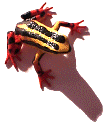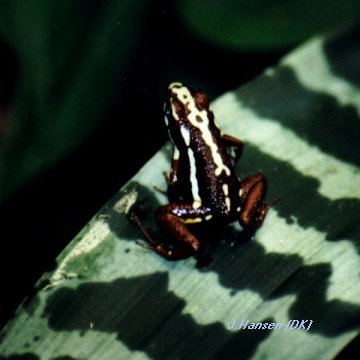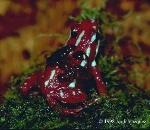
photo compliments of
Dr. Shin Sugiyama
 In an effort to determine the relative virulence of the toxins emitted
by various species the scientists agitated the frogs, causing them to secrete
the toxin, and then touched the frogs skin with their tongues. The
observations recorded in the study indicate that species of mild toxicity
produced a bitter taste, followed closely by numbness of the tongue and
tightening in the throat (Bainbridge, 1989). This method could not
be used with all species of frogs, however, because the more deadly species
- such as the Phyllobates terribilis - can secrete enough poison
to bring about the deaths of multiple humans (Bainbridge, 1989). This simple
test was not as dangerous as it may seem, though, for most dart frog toxins
are only deadly upon entering the bloodstream (Turkington, 1999).
However, the most potent toxins do quickly give rise to significant irritation,
including blistering and swelling (Turkington, 1999).
In an effort to determine the relative virulence of the toxins emitted
by various species the scientists agitated the frogs, causing them to secrete
the toxin, and then touched the frogs skin with their tongues. The
observations recorded in the study indicate that species of mild toxicity
produced a bitter taste, followed closely by numbness of the tongue and
tightening in the throat (Bainbridge, 1989). This method could not
be used with all species of frogs, however, because the more deadly species
- such as the Phyllobates terribilis - can secrete enough poison
to bring about the deaths of multiple humans (Bainbridge, 1989). This simple
test was not as dangerous as it may seem, though, for most dart frog toxins
are only deadly upon entering the bloodstream (Turkington, 1999).
However, the most potent toxins do quickly give rise to significant irritation,
including blistering and swelling (Turkington, 1999).
Photo compliments of Jesper Hansen
http://hjem.get2net.dk/jesper_hansen2/epipedob.html
Upon returning to the United
States with their sample species, Daly and his coworkers determined that
the secretions contained an alkaloid material which elicited a straub-tail
response - the raising and arching of the tail in mice injected with the
substance - characteristic of opiods (Strong, 1998). Shortly after
this discovery, Daly was forced to stop his research, for a period of more
than ten years, due to the introduction of an international treaty banning
the collection of the Epipedobates tricolor (Strong, 1998).  During this ban, Daly attempted to raise the frogs in captivity.
Unfortunately, he soon realized that the secretions rapidly lost their
analgesic effects and formed the hypothesis that the poison resulted as
a byproduct of some indigenous substance ingested in the wild (Moffet,
1995). The actual substance was not determined until 1997 when Daly
and other NIH researchers released the finding that the frogs build up
high levels of the alkaloid in their skin by eating a huge number of ants,
which also contain the deadly chemicals in small amounts. The more
ants eaten by the frogs, the greater the amount of alkaloid present in
their skin and the greater their overall toxicity. (Current Science, 1997)
During this ban, Daly attempted to raise the frogs in captivity.
Unfortunately, he soon realized that the secretions rapidly lost their
analgesic effects and formed the hypothesis that the poison resulted as
a byproduct of some indigenous substance ingested in the wild (Moffet,
1995). The actual substance was not determined until 1997 when Daly
and other NIH researchers released the finding that the frogs build up
high levels of the alkaloid in their skin by eating a huge number of ants,
which also contain the deadly chemicals in small amounts. The more
ants eaten by the frogs, the greater the amount of alkaloid present in
their skin and the greater their overall toxicity. (Current Science, 1997)